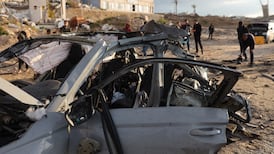Islamic State (IS) militants have “bulldozed” the renowned archaeological site of the ancient city of Nimrud near the northern Iraqi city of Mosul using heavy military vehicles, the government said.
A statement from Iraq’s ministry of tourism and antiquities did not elaborate on the extent of the damage, saying only that the group continues to “defy the will of the world and the feelings of humanity”.
The latest act follows an attack on the Mosul museum just days earlier. The destruction of the site of one of ancient Mesopotamia’s greatest cities recalled the Taliban’s annihilation of large Buddha statues in Afghanistan more than a dozen years ago, experts said.
Nimrud was the second capital of Assyria, an ancient kingdom that began in about 900 BC, partially in present-day Iraq, and became a great regional power. The city, which was destroyed in 612 BC, is located on the Tigris River just south of Iraq’s second largest city, Mosul, which was captured by IS in June. The late 1980s discovery of treasures in
Nimrud’s royal tombs was one of the 20th century’s most significant archaeological finds. After Iraq was invaded in 2003, archaeologists were relieved when they were found hidden in the country’s central Bank, in a secret vault-inside-a-vault submerged in sewage water. IS extremists, who control a third of Iraq and Syria, have attacked other archaeological and religious sites, claiming that they promote apostasy.
Earlier this week, a video emerged on militant websites showing Islamic State militants with sledgehammers destroying ancient artefacts at the Mosul museum, sparking global outrage.
Last year, the militants destroyed the Mosque of the Prophet Younis — or Jonah - and the Mosque of the Prophet Jirjis, two revered ancient shrines in Mosul. They also threatened to destroy Mosul’s 850-year old Crooked Minaret, but residents surrounded the structure, preventing the militants from approaching.
Iraq’s national museum in Baghdad opened its doors to the public last week for the first time in 12 years in a move prime minister Haider al-Abadi said was to defy efforts “to destroy the heritage of mankind and Iraq’s civilisation”.
IS has imposed a harsh and violent version of Islamic law in the territories it controls and has terrorised religious minorities.
It has released gruesome internet videos showing the beheading of captives, including captured western journalists and aid workers. A US-led coalition has been striking the group since August, and Iraqi forces launched an offensive this week to try to retake the militant-held city of Tikrit, on the main road linking Baghdad to Mosul.
Jack Green, chief curator of the Oriental Institute museum at the University of Chicago and an expert on Iraqi art, said IS seems bent on destroying objects they view as idols representing religions and cultures that do not conform to their beliefs. “It’s the deliberate destruction of a heritage and its images, intended to erase history and the identity of the people of Iraq, whether in the past or the present,” Mr Green said.
“And it has a major impact on the heritage of the region.” Mr Green noted that in many of these attacks on art, pieces that can be carried away are then sold to fund IS, while the larger artefacts and sculptures are destroyed at the site.












